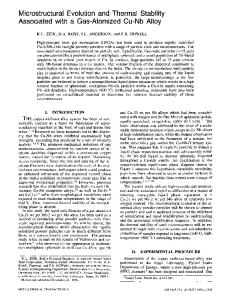Nanoindentation and microstructural evolution of polycrystalline gold
- PDF / 1,432,001 Bytes
- 12 Pages / 584.957 x 782.986 pts Page_size
- 84 Downloads / 354 Views
A finite-element (FE) microstructurally based dislocation density multiple-slip crystalline formulation that is coupled to molecular dynamic (MD) simulations has been used to predict how nanoindentation affects behavior in crystalline gold polycrystals at scales that span the molecular to the continuum level. Displacement profiles from MD simulations of nanoindentation were used to obtain scaling relations, which are based on indented depths, grain sizes, and grain aggregate distributions. These scaling relations are then used in a microstructurally based FE formulation that accounts for dislocation density evolution, crystalline structures, and grain sizes. This hierarchical methodology can be used to ascertain inelastic effects, such as shear-slip distribution, pressure accumulation, and dislocation density and slip-rate evolution at physical scales that are commensurate with ductile behavior at the microstructural scale. I. INTRODUCTION
As nanocrystalline grain sizes are refined, one of the few available experimental techniques to accurately estimate material properties is nanoindentation, which can be used to determine material hardness and elastic and inelastic response. However, reliable nanoindentation measurements of material properties of nanocrystalline materials have been severely hampered by an inability to account for different physical mechanisms, such as grain-boundary (GB) effects, dislocation activities, and GB sliding that span different scales in ductile materials. Numerous studies have clearly indicated that inelastic behavior is difficult to characterize by nanoindentation because of localized dislocation activities over small volumes that can be dominated by a large fraction of GB surfaces (e.g., see Ref. 1). Furthermore, crystalline aggregates, which can be comprised of a collection of nanograins, can approach microscales. Hence, the transition from the nano to the micro level behavior needs to be better understood and accurately predicted, such that indentation can be used to accurately predict material behavior for the potential tailoring of crystalline aggregates for desired applications. The accurate measurement of the hardness of bulk and thin film crystalline materials, such as gold and copper, is critical because of the utility of these crystalline materials as coatings and conductors for semiconductor, microelectronic, and biomedical applications. Gane and Bowden2 used a scanning electron microscope (SEM) and microindentation to determine the microstrength and a)
Address all correspondence to this author. e-mail: [email protected] DOI: 10.1557/JMR.2009.0133 J. Mater. Res., Vol. 24, No. 3, Mar 2009
http://journals.cambridge.org
Downloaded: 14 Mar 2015
microdeformation of gold, copper, and aluminum crystals. Atomic force microscopy (AFM) was used to investigate the hardness of gold thin films by applying the projected area calibration.3 Indentation was used to determine the hardness of several materials including gold single crystals,4 and it was determined that hardness decreased wit
Data Loading...











